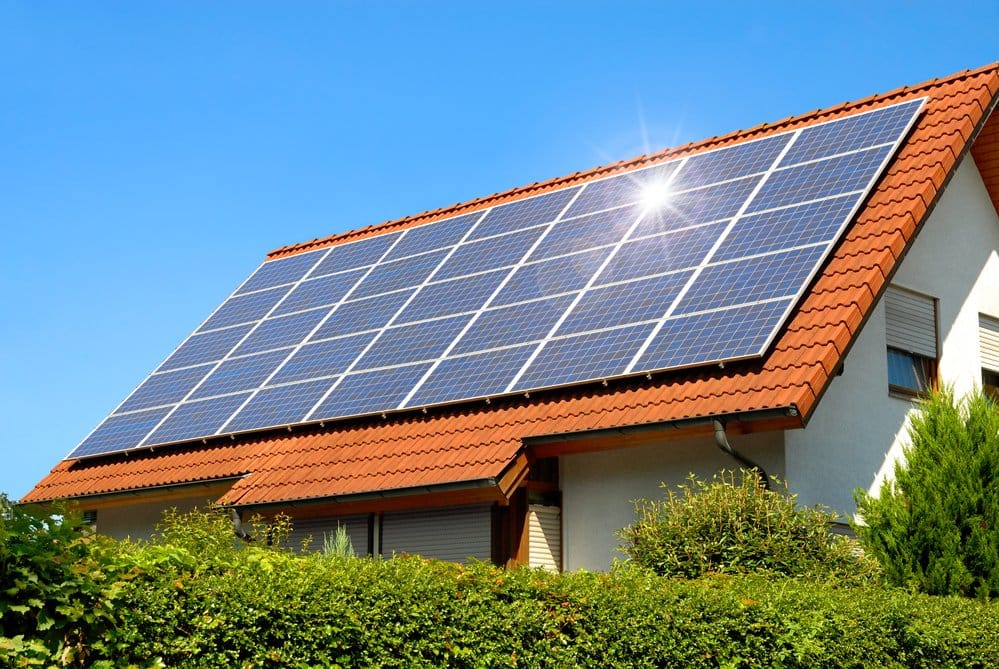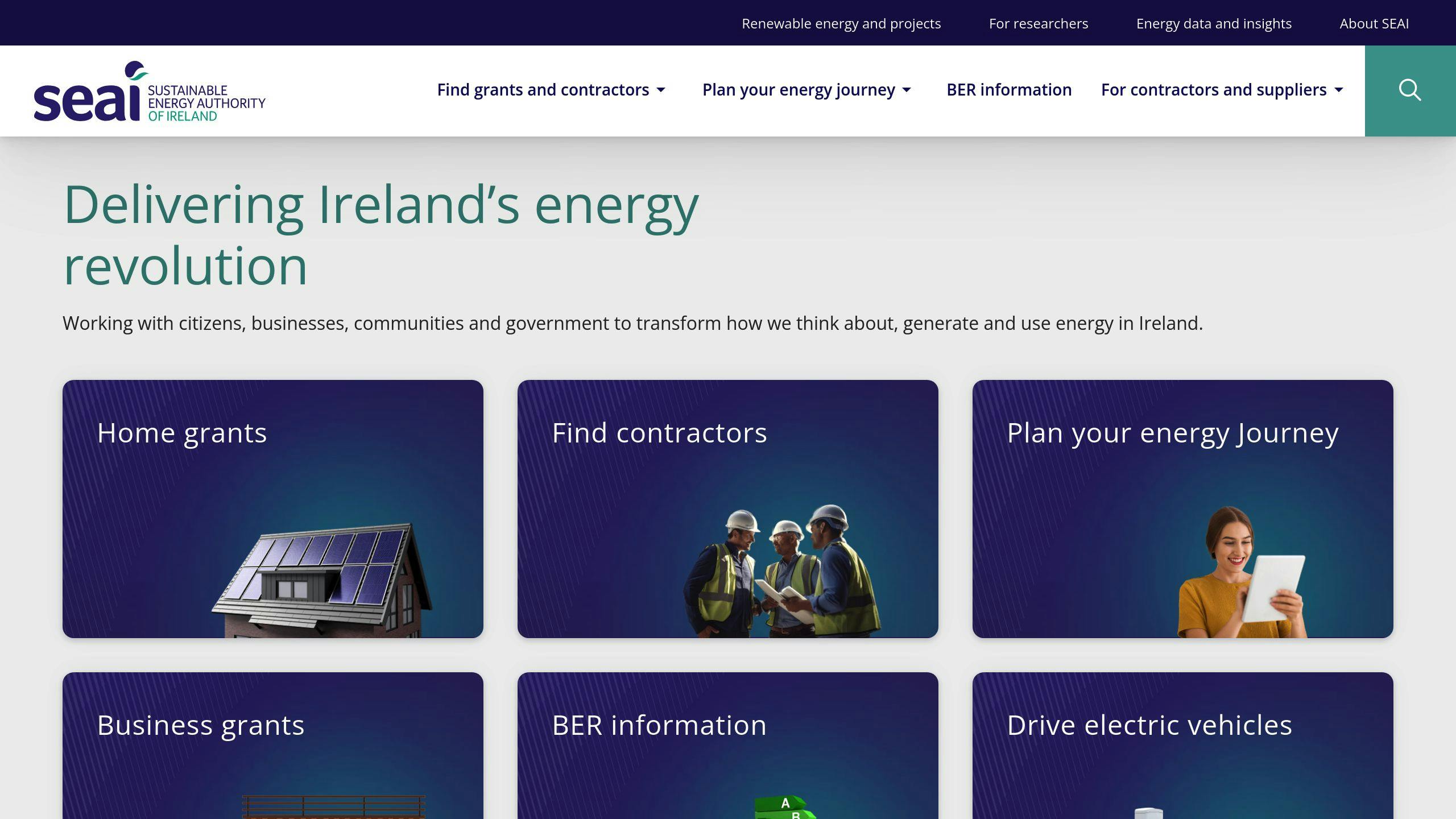2025 Irish Solar Panel Grants: What You Need to Know
Learn about Ireland's solar panel grants in 2025, including eligibility, application steps, and how to maximize your benefits.

Ireland's 2025 solar panel grants, managed by SEAI, aim to reduce installation costs and promote renewable energy. Here’s the key information at a glance:
- Grant Amounts: Up to €1,800 for residential solar systems, based on size (e.g., €1,425 for 2.5 kWp, €1,800 for 4.0 kWp systems).
- Eligibility: Homes built before 2021, owned by the applicant, with installations done by SEAI-approved installers.
- Application Timeline: Approval takes 20 working days; installations must be completed within 8 months, and reimbursements are processed in 4-6 weeks.
- Steps to Apply:
- Register on the SEAI Claims Portal.
- Provide your MPRN, proof of ownership, and post-installation BER certificate.
- Coordinate with ESB Networks for grid connection.
Act fast - grant amounts decreased from €2,100 in 2024 to €1,800 in 2025. Start your application early to maximize savings and contribute to Ireland’s renewable energy goals.
Eligibility for Solar Panel Grants
Property and Ownership Requirements
To qualify for the SEAI Solar PV Grant, you must meet specific property and ownership criteria. First, the property must have been built and occupied before 2021, and you must own it - tenants are not eligible. You'll need to provide proof of ownership, the property's Meter Point Reference Number (MPRN), and evidence that the property was occupied before 2021.
Additionally, the installation must be carried out by an SEAI-registered company and certified electricians from Safe Electric Ireland. You can verify these professionals through the SEAI website [4][5].
Here's a quick breakdown of the main requirements:
| Requirement Type | Details |
|---|---|
| Property Age | Built before 2021 |
| Ownership Status | Must be the property owner |
| Installation Team | SEAI-registered company |
| Electrical Work | Safe Electric Ireland certified |
Building Energy Rating (BER) Requirements
After your solar panels are installed, you'll need to hire an SEAI-registered BER assessor to evaluate your home's energy performance. This assessment must be done post-installation to reflect the energy improvements accurately. The resulting BER certificate is a key part of your grant application [4][5].
Grant amounts in 2025 vary depending on the size of the system installed. Here's a quick look at the grant values:
| System Size | 2025 Grant Value |
|---|---|
| 2.5 kWp | €1,425 |
| 3.0 kWp | €1,550 |
| 3.5 kWp | €1,675 |
| 4.0 kWp | €1,800 |
"The BER certificate must be conducted by a registered BER assessor listed on the SEAI's National Register of BER Assessors, ensuring compliance with all necessary standards" [4].
Keep in mind that your grant application must be approved before installation begins. The approval process can take up to 20 working days [4][5]. Meeting these criteria ensures you're eligible for grants that can help make solar energy more accessible and cost-effective.
Next, let’s look at how to navigate the application process with ease.
Applying for a Solar Panel Grant
Application Steps
Applying for an SEAI solar panel grant requires attention to detail and proper documentation. Start by registering on the SEAI Claims Portal. Initial approval typically takes around 20 working days, and once approved, you’ll have 8 months to complete the installation [4][5].
Make sure you have the following:
- Your MPRN (found on your electricity bill)
- Proof of property ownership
- Documents showing occupancy before 2021
- Your BER certificate number
- Details of your SEAI-registered installer
Before starting the installation, you’ll also need to apply to ESB Networks for an electricity connection [5].
| Application Stage | Timeframe | Key Requirements |
|---|---|---|
| Initial Processing | 20 working days | Complete documentation |
| Installation Window | 8 months | SEAI-registered installer |
| Grant Payment | 4-6 weeks | Post-installation verification |
Avoiding Common Application Errors
Mistakes can delay or even void your grant application. For instance, starting the installation before approval is a common reason for rejection, as noted by Energia [5].
Here are some tips to keep things on track:
- Check Installer Credentials: Make sure your installer is listed as an SEAI Solar PV Approved Installer [4].
- Submit All Documents: Missing paperwork can slow down the process, so include everything in your initial submission.
- Monitor Your Application: Use the SEAI portal to track progress and respond promptly to any requests.
Some solar panel companies offer services to help with the grant application process. They handle the paperwork and ensure everything complies with SEAI regulations [5].
Keep in mind, applying before January 2025 could save you money. The maximum grant amount will drop from €2,100 to €1,800 after that date [1].
Installation and Grant Reimbursement
Using Approved Solar Installers
To qualify for the grant, you must hire an SEAI-approved installer. These professionals ensure your solar panel installation meets all standards and handles everything from start to finish, including grid connection requirements.
Here’s how the process works:
1. Initial Assessment
Your installer will inspect your property to determine the best system size and placement. They’ll also check the building’s structure and electrical setup to ensure compatibility.
2. ESB Networks Application
The installer submits the NC6 form, which notifies ESB Networks about your solar system’s grid connection. Approval for this step usually takes at least 20 working days [5].
3. Installation and Certification
Once ESB Networks approves the connection, the installation begins. Afterward, you’ll need a Building Energy Rating (BER) assessment from a certified assessor listed on SEAI’s National Register of BER Assessors [4].
The ESB Networks approval process takes about 20 working days. Installation typically lasts 1-3 days, and the BER assessment takes another 1-2 days. Coordinate with your installer to stay on schedule.
Once the installation is complete, the next step is submitting the required paperwork to claim your grant reimbursement.
Invoices and Reimbursement Timeline
Submitting accurate paperwork is key to getting reimbursed. You’ll need to provide detailed invoices, a Declaration of Works from your installer, and an updated BER certificate.
SEAI usually processes grant payments within 4-6 weeks after receiving all the necessary documents [5]. To avoid delays, double-check everything before submission.
"Solar panels can save homeowners up to €400 per year on their electricity bills while contributing to Ireland's renewable energy targets" [1][3].
Act quickly to complete the installation and paperwork so you can take full advantage of the grant and start benefiting from your solar investment.
Maximizing Solar Panel Grant Benefits
Choosing the Right Solar Panel System
When selecting a solar panel system, think about your household's energy needs, the space available on your roof, and your budget. Efficient panels can generate more electricity, and proper placement is key for getting the most out of your system - even in Ireland's often cloudy weather. It's all about finding the sweet spot between upfront costs and long-term savings, especially with grant support in the mix.
Here are some key points to keep in mind:
- Energy Use: Look at your household's typical energy consumption patterns. This helps determine the system size you need.
- Installation Factors: Check your roof’s solar potential, including its orientation and available space.
- Cost vs. Savings: Weigh the initial costs against potential savings over time, factoring in grants and reduced energy bills.
Once you’ve chosen the right system size, think about adding advanced features to get even more out of your solar setup.
Future-Proofing with New Technologies
New solar technologies are giving Irish homeowners more ways to improve their systems. For example, energy storage solutions like the Tesla Powerwall can store unused energy, providing backup power during outages and better control over energy use.
"The integration of energy storage solutions like Tesla Powerwall can help homeowners maximize their solar investment by storing excess energy for use during peak demand periods" [4].
Other advancements, like smart inverters and hybrid systems, can boost efficiency and give you more energy independence. These tools let you store surplus energy, fine-tune system performance, and prepare for future energy needs.
SEAI Solar PV Grant Changes in 2025

Conclusion: Key Points
In 2025, Irish solar panel grants continue to provide financial support for renewable energy projects, even with a €300 reduction in the maximum grant value compared to 2024. These grants are available for both residential and commercial properties, although the eligibility criteria differ.
Here’s what you’ll need to qualify:
- Your property must have been built and occupied before 2021 [4].
- A Building Energy Rating (BER) assessment must be completed after installation.
- The installation must be carried out by an SEAI-registered installer.
Once these requirements are met, you can apply for the grant. Approval typically takes 20 working days, and reimbursement is issued within 4–6 weeks after submitting the necessary documents [5]. Make sure to have your MPRN number, BER certificate, and proof of homeownership ready before starting your application [2].
When planning your solar installation, consider both your current and future energy needs. The SEAI Solar PV grant can cover up to €1,800 of installation costs [4], helping Irish homeowners reduce long-term electricity expenses while making a meaningful investment in renewable energy.
Don’t forget to complete the ESB Networks application, which is required to connect your system to the national electricity grid [4][5]. This step ensures your solar panels operate effectively within Ireland’s power infrastructure.
While the grants primarily target homeowners, businesses and other non-domestic properties can also benefit under separate criteria and processes [6]. These grants play an important role in supporting Ireland’s shift toward renewable energy, benefiting both residential and commercial sectors in the move to cleaner power sources.

